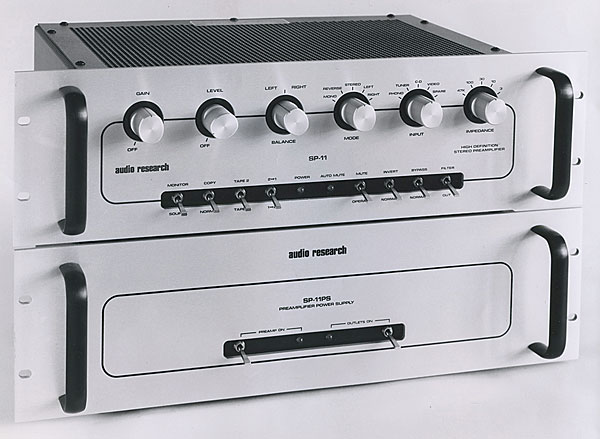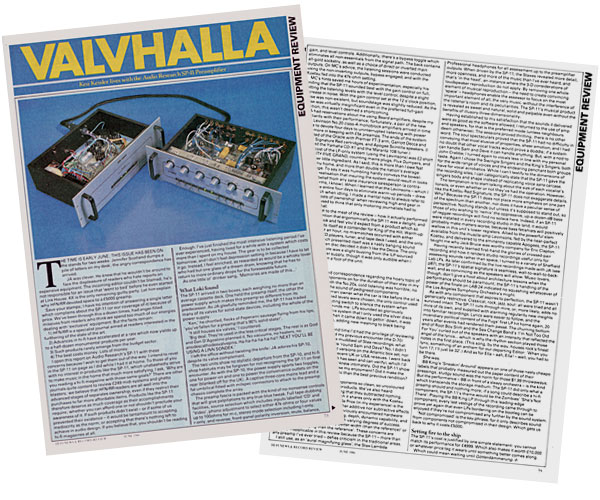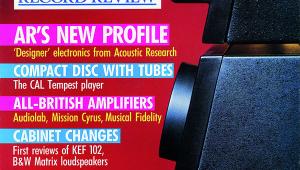Valvhalla Page 2
Before we get to the meat of the review – how it actually performed – I ought to mention that ergonomically the SP-11 was a delight, and that it has the look and feel you'd expect from a product which so blatantly presents itself as a contender for King of the Hill. Warm-up period was about an hour, no mismatches occurred with either cartridge or the CD player and tuner I used, and the only heart-stopper which presented itself was a nasty banging sound when a static-ridden disc decided it didn't like the Decca. The only other concern of note was a slight buzzing from the ILP-sourced toroidal in the power suppIy, though it was only audible when I placed my ear within a foot of the unit.
Odin Beckons
l left all components powered up for the duration of their stay in my system. Particularly with the No20s, cold listening was just horrible; no other word describes the sound of pedigreed components misbehaving. (Ask a Ferrari owner what the car is like before the oil is warm.) Once my preferred levels were chosen, the only control used on the SP-11 was the muting switch to silence the system when changing LPs. Which reminds me: LPs sounded so gloriously superior to CD through this system that I only used the silver discs for comparison's sake. When it came down to gettin' down, it was music on vinyl all the way.

As this was only the second time I'd had the privilege of reviewing a piece from the Master, and my previous encounter (the D-70) resulted in greater insight into the muddiest of Stax recordings, what could I do but wrap the Oracle 'round Sam and Dave? No, I didn't play the digitally-reprocessed versions on the Atlantic box set, or the Japanese pressings, or recent UK or US reissues. I went back to the originals, which I'd played innumerable times and knew intimately. Did the SP-11 show me anything new? Did it increase my enjoyment? Did it make the performance more realistic than the best previous rendition? Yes.
We've all heard individual components so clean, so uncoloured that they added no unwanted by-products. We've also heard components so open and revealing that they subtracted nothing. What the Audio Research SP-11 has, a quality which it shares only with the Koetsu Red Signature and the Stax Lambda Pros (in my experience) is the ability to yield signal suffering neither additive nor subtractive effects in perfectly natural perspective. Previously encountered hardware would improve soundstage, imaging, depth, dynamic capability, and other perspective-related details with varying degrees of success. We would use terms like 'slightly better width (than the reference)' or 'more precise imaging than the reference'. These concerns are virtually inapplicable in this review simply because the SP-11 – more than any preamp I've ever tried – defies criticism in the traditional areas.
I still use, as an 'aural magnifying glass', the Stax Lambda Professional headphones for all assessment up to the preamplifier outputs. When driven by the SP-11, the Staxes revealed more detail, more openness, and more of the music than I've ever heard, and that's 'in the head', an instance where the 3D considerations of loudspeaker reproduction do not apply. By removing one whole element of musical reproduction – the need to create convincing 'space' – headphones enable the assessor to focus on the most important element of all, the very music, without the interference of the listening room used and its peculiarities. The SP-11's musical product is revealed as sweet and natural, solid and palpable even without the benefits of illusory three-dimensionality.
Vocal Acrobatics
Having established to my satisfaction that the sounds it delivered were as good as the software allowed, I returned to the use of amp and speakers, for that is the preferred mode (unless neighbours deem otherwise). The sessions proved thrilling; there is no other word. The soul spectaculars proved that the SP-11 had no difficulty in conveying that most elusive of properties, sheer emotion, and I had no doubt that other vocal tracks would prove a doddle. If a system can handle Sam and Dave it can handle anything. But, with a nod to former HFN editor John Crabbe, I decided to turn to vocals that are less in line with my personal taste.
I chose the Swingle Singers and the King's Singers, both for the wide range of voices and the endearing penchant both groups have for vocal acrobatics. While I can't testify to the dimensions of the recording sites, I can categorically state that the Audio Research SP-11 gave the singers body and shape instead of replicating voice sans carcass.

The temptation is to start talking about the size of each vocalist's tonsils, or even whether or not they've had the operation. However, like the Koetsu Red Signature, the SP-11 does not exaggerate details. Why? Because the SP-11 does not place more emphasis on one part of the spectrum than another, nor does it have a peculiar sense of perspective. Nothing stands out unless it's supposed to stand out, so those of you wishing to 'remix' the oppressive, up-a-dozen-dB bass of reggae recordings will find no solace here. Indeed, if an SP-11 were installed in every recording studio in the land, it would probably make matters worse, because bass fetishists will positively wallow in this unit's lower registers.
Allied to the powerful slam available from the muscle-amp Levinson monoblocks, fed by the near-perfect Koetsu cartridge, and delivered to the eminently capable Apogee loudspeakers, the SP-11 taught me why Jack Bruce was worthy company for Eric Clapton.
Nice 'N' Sleazy
Having recently learned first-hand the glories of crossed-pair recording and how it renders studio recordings useful only for assessing sounds rather than space, I turned to a variety of Sheffield Lab LPs. Here the SP-11's spatial signature is seamless, wall-to-wall-to-backwall, and as convincing as the speakers will allow. Music lovers, though, don't give a hoot about architecture lessons when the performance should be paramount; the SP-11's handling of the power of the finale on LAB 24 indicated no squashing whatsoever of the Los Angeles Symphony Orchestra's might.
As with any component that aspires to perfection, the SP-11 wasn't generically restrictive. Classical, rock, jazz, soul – all were tried and all survived intact. The SP-11 cuts through mire, or, more likely, adds no mire of its own, and supplied with alarming regularity new insights into familiar recordings. Lyrics were easier to follow, meaning that the incendiary political content of The Fugs' first album hit home again, 20 years after events had rendered them passé.
Meanwhile, the churning bottom end of Root Boy Slim And The Sex Change Band's 'I'm Not Too Old For You' curled out of the speakers with an intensity that reflected the angst of the lyrics... which is why the rhythm section played those notes in the first place. (This song, by the way, houses rock's finest lyric, something of an anthem for our departing editor: 'When you turn 17, I'll just be 32'.) And as for Ella – aah, Ella! Well, let's just say you had to be there. After all, she was.
BB King's 'Sneakin' Around' appears on one of those cheapo labels that probably measured out the paper content of its pressings – sludgy sound was the norm for those $1.99 throwaways. But the performance – BB in front of a sleazy orchestra – is the kind which transcends the storage medium. The SP-11 did only what a preamp should and nothing more. If a song could describe a hi-fi component, the SP-11's theme would be The Zombies' 'She's Not There'. Playing the BB King LP through this leading-edge component, every last vestige of the recording came through to prove yet again that even LPs bordering on the bootleg can be enjoyed if they're not compromised any further by the sound system.
Setting Fire To The Ship
'Not compromised' is the key phrase, for it only describes sound from components not compromised in their design. Which gets us back to why this preamp costs £5000.
The SP-11's cost is justified by one simple statement: you simply cannot match its performance for £4999. Which also makes it worth £10,000 or whatever price tag it wears until something better comes along. Which could mean waiting until Götterdämmerung.


















































